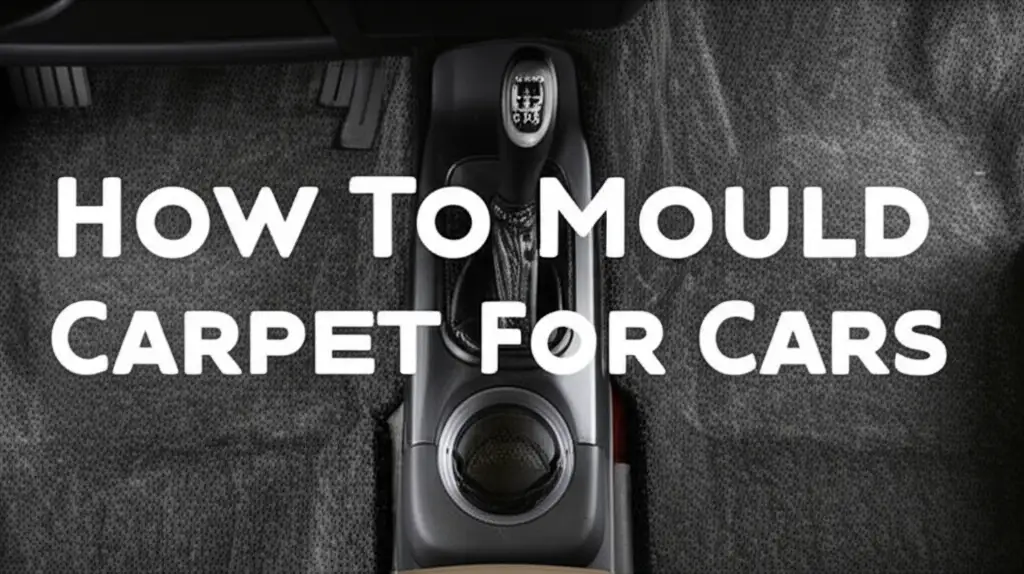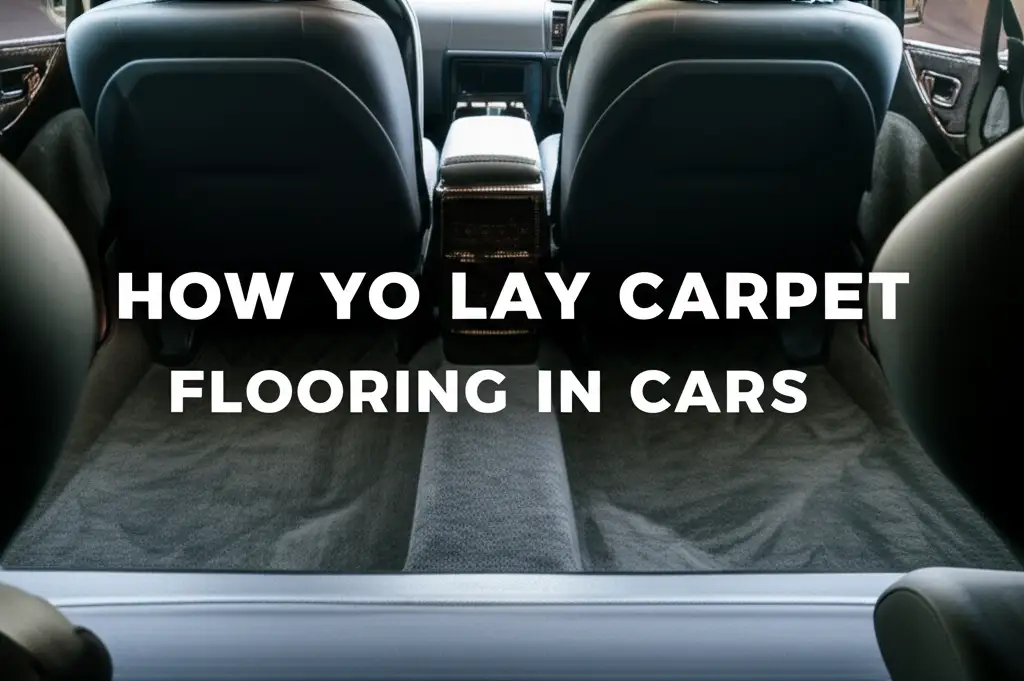· Mason Everett · Automotive · 14 min read
How To Mould Carpet For Cars

How To Mould Car Carpet Like A Pro
Have you ever looked at your car’s worn-out carpet and wished for a fresh, custom look? Moulding carpet for cars might seem like a hard job, but it is a rewarding DIY project. Creating a new, perfectly fitted car carpet can totally change your vehicle’s interior. You can achieve a professional finish with the right steps and tools.
This guide will show you how to mould carpet for cars from start to finish. We will cover choosing materials, gathering tools, and step-by-step moulding methods. You will learn how to make templates, use heat correctly, and install your new carpet smoothly. Get ready to give your car’s interior a fresh, custom upgrade.
Takeaway
- Gather all necessary tools and materials before starting the project.
- Create an accurate template from your car’s floor pan for a perfect fit.
- Use a heat gun carefully to shape the carpet, avoiding direct contact.
- Ensure proper sound deadening and insulation for a quiet ride.
- Install the new carpet securely with suitable adhesive and trim.
To mould carpet for cars, you first remove the old carpet and make a precise template of the floor pan. Then, you cut the new automotive carpet using this template. Finally, you carefully apply heat with a heat gun to shape the carpet, making it fit the contours of your car’s floor perfectly before securing it in place.
Understanding Car Carpet Moulding
Moulding carpet for cars means shaping flat carpet material to fit the bumps and curves of a vehicle’s floor. Car floors are not flat surfaces. They have many contours, transmission tunnels, and seat mounts. Standard flat carpet rolls cannot fit these shapes without folds or creases.
This shaping process creates a smooth, factory-like appearance. It removes gaps and wrinkles that ruin the look of your car’s interior. People mould carpet for many reasons. They want to replace old, worn-out carpet or customize their car’s look. It is also good for improving sound insulation.
You can mould car carpet yourself with patience and the right tools. The result is a clean, custom interior that feels new. This method ensures your carpet lies flat and looks great, just like a professional job. It offers a huge upgrade to your car’s comfort and value.
Essential Tools and Materials for Moulding Car Carpet
Starting a car carpet moulding project needs specific tools and materials. Having everything ready saves time and ensures a smooth process. You need a few key items to achieve a perfect fit. Proper planning makes the job much easier.
First, you need the right automotive carpet. Not just any carpet will work; What is car carpet made of? Most automotive carpets have a special backing that helps with moulding. This backing also resists moisture and wear, which is important for a car environment. You can find pre-backed carpet designed for cars at auto upholstery stores.
Next, gather your tools. You will need a good pair of sharp scissors or a utility knife for cutting. A heat gun is very important for moulding the carpet. Use a spray adhesive designed for automotive use to secure the carpet. Also, have a sturdy template material like poster board or heavy paper.
Here is a list of essential items:
- Automotive Carpet: Choose a high-quality, flexible material.
- Heat Gun: This tool helps shape the carpet.
- Sharp Scissors or Utility Knife: For precise cutting.
- Spray Adhesive: A strong, automotive-grade glue.
- Template Material: Large sheets of paper, cardboard, or clear plastic.
- Marking Pen or Chalk: To trace outlines on your template and carpet.
- Measuring Tape: For accurate dimensions.
- Staple Gun or Clips: To hold the template in place.
- Safety Gloves and Eye Protection: Always important when working with tools and heat.
Having these items ready before you start will make the moulding process much more efficient. This preparation also helps you avoid mistakes during the project.
Preparing Your Vehicle for Carpet Moulding
Before you start moulding new carpet, your car needs thorough preparation. This step is crucial for a successful outcome. A clean and clear work area helps you get precise measurements and a perfect fit for your new carpet. Do not rush this part of the job.
First, remove all old carpet, floor mats, and any loose debris from the car’s interior. You will likely need to take out seats, the center console, and any trim pieces that cover the carpet edges. This gives you full access to the floor pan. Take pictures as you go, or label parts to remember how they go back together.
After removing the old carpet, clean the metal floor pan thoroughly. Vacuum all dirt and dust. Then, use a suitable cleaner to remove any grease, oil, or stubborn stains. A clean surface helps new adhesive stick better. If your old carpet had bad smells, cleaning the floor pan helps remove them. For persistent odors, consider methods like those used to get dog smell out of cars carpet.
Inspect the floor pan for any rust, holes, or damage. Address these issues before laying new carpet. You might need to sand down rust or patch small holes. This ensures a smooth and solid base for your new carpet. A good base makes the new carpet look much better and last longer. The principles of removing floor coverings are similar across surfaces, even when you take the carpet out of tile floor, the core idea is preparation.
The Process of Moulding Automotive Carpet: Step-by-Step
Moulding automotive carpet involves several key steps. Each step builds on the last to create a perfectly fitting new carpet for your car. This process requires patience and precision. Following these steps carefully will lead to great results.
1. Create a Template: Start by making an accurate template of your car’s floor pan. Use large sheets of paper, cardboard, or clear plastic. Lay the material over the clean floor pan, pressing it into all the contours. Use a marker to trace the exact shape of the floor, including all bumps, curves, and bolt holes. Cut this template out precisely. This template is your pattern for the new carpet.
2. Transfer Template to New Carpet: Place your finished template onto the back of your new automotive carpet. Make sure the carpet pile runs in the correct direction; usually, all carpet sections should have their pile running the same way. Use a marker or chalk to trace the template’s outline onto the carpet backing. Double-check your lines before cutting. This step ensures you do not waste material.
3. Cut the Carpet: Carefully cut out the carpet piece using sharp scissors or a utility knife. Cut slightly outside your marked lines, leaving about 1 to 2 inches of extra material around the edges. You can trim this excess later. Cutting larger helps avoid making the carpet too small. Precision here saves time later.
4. Heat Moulding the Carpet: This is the main part of how to mould carpet for cars. Lay the cut carpet piece in your car’s floor pan. Identify areas that need shaping, like the transmission tunnel or wheel wells. Use a heat gun on a low to medium setting, holding it a few inches from the carpet’s backing. Gently warm the carpet backing in the area you want to mould.
As the carpet warms, it becomes more flexible. Carefully press and shape the carpet into the floor’s contours. Use your hands, a roller, or a blunt tool to help form the shape. Work slowly, applying heat and shaping in small sections. Avoid overheating the carpet, as it can damage the material or cause burns. Repeat this process until the carpet fits snugly into all curves.
5. Trim and Test Fit: Once the carpet is moulded, test fit it in the car again. Trim any excess material from the edges using your sharp scissors or knife. Make sure all edges align with the car’s existing trim lines. Cut out openings for seat bolts, seat belts, and other fixtures. Take your time to make these cuts clean and accurate.
Installing and Finishing Your Custom Moulded Carpet
After successfully moulding your car carpet, the next steps involve installation and finishing. This stage brings your project to life, making your vehicle’s interior look completely new. Proper installation ensures the carpet stays in place and looks professional. It is about more than just laying it down.
First, consider adding sound deadening material or extra insulation to your floor pan. This is a great time to do it, as the floor is already bare. Sound deadening improves ride comfort by reducing road noise. It also adds a layer of thermal insulation. Apply this material directly to the metal floor pan before installing the carpet.
Next, apply automotive-grade spray adhesive to both the floor pan and the back of your moulded carpet. Follow the product’s instructions for drying times and application. Spray adhesive creates a strong bond, keeping the carpet from shifting. Make sure to spray evenly to avoid bubbles or loose spots. For general tips on how to keep a carpet down, many principles apply here, such as ensuring a good adhesive bond.
Carefully lay the moulded carpet into the car, starting from one end and working your way across. Smooth out any wrinkles or air bubbles as you go. Press the carpet firmly into all the contours of the floor. You can use a roller or your hands to ensure good adhesion everywhere. Pay special attention to edges and areas around curves.
Finally, reinstall all the removed components, like seats, consoles, and trim pieces. Make sure all seat belt anchors and bolt holes line up correctly. Double-check that all trim pieces snap back into place properly. The edges of your new carpet should be neatly tucked under the trim, giving a clean, factory-finished look. This careful reassembly completes the transformation.
Tips for Achieving Professional Car Carpet Moulding
Achieving a professional finish when moulding carpet for cars involves more than just following the steps. Some clever tips can make a big difference. These insights help avoid common mistakes and ensure your custom carpet looks its best. Paying attention to these details will elevate your results.
Firstly, always use the old carpet as a guide if it is still intact. Even if it is worn, it still holds the original shape of your car’s floor. Lay your template material over the old carpet to trace the rough shape. Then, refine it by fitting it directly onto the bare floor pan. This dual approach helps you get a very accurate template.
When using the heat gun, work in small sections. Do not try to heat a large area at once. Heat a small portion of the carpet backing until it feels warm and flexible. Then, press it firmly into the contour. Once it cools, it will hold its new shape. This slow, steady approach prevents overheating and ensures better shaping. Always keep the heat gun moving to prevent burning the carpet.
Consider using a vacuum former if you are doing a complex car or many carpets. A vacuum former pulls the softened carpet tightly into the mould, creating very crisp contours. While this is more advanced, it yields factory-perfect results. For home DIY, proper heat gun technique and hand pressing work well.
Also, think about adding a protective layer over your new carpet. This can be clear floor mats or a specialized carpet protector. This extra layer helps maintain the carpet’s appearance and lifespan. For more ideas, you might research what can I put over carpet to protect it. It protects against spills, dirt, and wear, keeping your custom carpet looking fresh for years.
Finally, do not rush the trimming process. After the carpet is moulded and mostly in place, take your time to trim the edges perfectly. Use sharp scissors and cut in small increments. A well-trimmed edge makes a huge difference in the final look. Neat edges give a truly custom, professional appearance to your moulded car carpet.
Maintaining Your New Car Carpet
After spending time moulding and installing your new car carpet, proper maintenance is key. Keeping your custom carpet clean and protected will help it last longer and look great. Regular care prevents dirt buildup and wear, preserving your hard work. Simple habits can make a big difference.
Regular vacuuming is the first step in maintaining your car carpet. Use a strong vacuum cleaner to remove dirt, dust, and small debris. Do this weekly or bi-weekly, depending on how much you use your car. This prevents dirt from grinding into the carpet fibers, which causes wear over time. Make sure to get into all the nooks and crannies.
For spills and stains, act fast. Blot liquids immediately with a clean cloth. For solid spills, scoop up as much as possible before blotting. Use a suitable carpet cleaner designed for automotive use. Always test the cleaner on a small, hidden area first to ensure it does not harm the carpet’s color or texture. Different types of stains may need specific treatments, for example, if you need to clean cheese out of carpet.
Deep cleaning your car carpet at least twice a year is also a good idea. This removes embedded dirt and refreshes the carpet’s appearance. You can use a carpet extractor or professional cleaning services. Understanding options like can you dry clean a carpet can help you choose the best deep cleaning method. Similarly, knowledge about how to clean a machine-made carpet cleaning might also provide useful insights.
Consider using floor mats over your new moulded carpet. Floor mats provide an extra layer of protection against daily wear, dirt, and spills. They are easier to remove and clean than the entire carpet. Choose mats that fit well and stay in place to avoid slipping. This simple addition greatly extends the life of your custom car carpet.
FAQ Section
What type of carpet is best for moulding cars?
The best carpet for moulding cars is automotive-grade carpet with a pliable, often rubberized, backing. This backing allows the carpet to soften and hold shape when heat is applied. It also offers durability, sound insulation, and moisture resistance, which are important for a car’s environment.
Can I mould carpet without special tools?
You cannot mould carpet for cars effectively without a heat gun. A heat gun is the main tool that makes the carpet flexible enough to conform to the car’s contours. Other tools like sharp scissors, a template material, and spray adhesive are also necessary for a good result.
How long does car carpet moulding take?
The time it takes to mould car carpet varies. It depends on your skill level and the complexity of your car’s floor. For a first-timer, preparing the car, making templates, moulding, and installing can take 8-16 hours. Experienced people might finish faster.
Is it hard to mould car carpet?
Moulding car carpet is not extremely difficult, but it requires patience and attention to detail. The most challenging parts are creating an accurate template and carefully applying heat to form the carpet without damaging it. With practice and following a good guide, most DIYers can achieve good results.
How much does it cost to mould car carpet?
The cost of moulding car carpet depends on the price of materials. Automotive carpet typically costs between $50 to $150 for enough material for an entire car. Tools like a heat gun or adhesive are often bought once and used for many projects. It is much cheaper than professional installation.
Do I need to remove seats to mould car carpet?
Yes, you need to remove the car seats, center console, and any trim pieces that cover the carpet edges. This gives you full access to the car’s bare metal floor pan. A clear floor pan is crucial for making an accurate template and properly moulding the new carpet.
Conclusion
Moulding carpet for cars can seem like a big job at first glance. Yet, with the right approach, it is a very rewarding DIY project. You gain a perfectly fitted, custom interior that transforms your vehicle’s look and feel. We have explored every step, from preparing your car and gathering tools to the actual heat moulding and final installation.
Remember to be precise with your template and patient with the heat moulding process. Small, controlled steps lead to the best outcomes. A fresh, custom car carpet makes your vehicle more enjoyable and can even boost its resale value. It shows care and attention to detail.
So, if you are ready to give your car a significant interior upgrade, start planning your moulding project today. You now have the knowledge to achieve professional results right in your garage. Go ahead and create that stunning, custom look you have always wanted for your car. Your efforts will pay off with a beautiful, comfortable interior that you will love.





